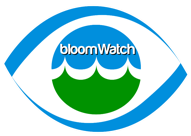bloomWatch

bloomWatch is a participatory science app that allows users to find and report potential cyanobacteria blooms in water bodies. The data users provide help government scientists to track and manage water quality and help officials protect public health and the environment from harmful blooms. Download the bloomWatch app today to report suspected harmful algal blooms in your community’s water bodies.
Why use bloomWatch?
- Have you noticed that a waterbody suddenly turned the color of pea soup or looks like a blue-green paint spill? Or do you see green clumps, mats, flakes or filaments floating in a water body? Then you may be witnessing a potentially toxic bloom.
- Blooms in fresh water bodies are commonly due to cyanobacteria, which have the potential to produce toxins that can harm people, pets, and our ecosystems.
- Originally a project of the Cyanobacteria Monitoring Collaborative (CMC) and facilitated by the EPA Region 1, data collected via bloomWatch helps scientists at government agencies understand where and when these blooms may be causing issues so they can help protect communities.
- State and local officials cannot watch every water body at all times
- By using the bloomWatch app, you can help document the prevalence and location of suspected cyanobacteria blooms.The app notifies participating state and Tribal partners in real-time when a bloomWatch observation is submitted.
How does bloomWatch work?
- Step 1. Download the app
- Install the bloomWatch app from the Apple App Store onto your iOS smartphone or tablet.
- Install the bloomWatch app from the Google Play Store onto your Android smartphone or tablet.
- A web version of the app is also available to be used for reporting suspected HABs.
- Step 2. Learn what to look for
- Get familiar with the appearance of cyanobacteria blooms. The app also has example pictures.
- The appearance and texture of cyanobacteria blooms may resemble: pea soup, spilled paint, parallel green streaks, surface dots.
- Step 3. Report suspected blooms with the bloomWatch app
- Collect information related to location and characteristics of the bloom. This includes coordinates, surface conditions, and the size of the bloom. Additionally, information on public access to the waterbody (boating, swimming etc.) can help provide insight on the risk of a potential HAB to the general public.
- Follow instructions on the app to take good photos of potential blooms. Photos should include the following: 1) an image showing the maximum extent of the bloom to help determine if the bloom is isolated or waterboy wide 2) an image of the bloom from a standing position, ten to thirty feet away which can help show if the bloom is stacking up along the shoreline 3) a close-up image of the bloom to help show if the bloom is filamentous, streaky or in clumps.
- Finalize and submit your observation and photos.
NOTE: When in doubt, stay out! Avoid suspected blooms and keep people and pets from having direct contact with the water.
Where have bloomWatch reports been submitted?
- bloomWatch Dashboard: Observations reported via the app are available through the bloomWatch dashboard, a service of ArcGIS online. The dashboard allows users to explore observations submitted at any spatial scale and with various filtering tools to get the most out of understanding when, where, and what types of blooms are occuring in present time, or in the past.
- How’s My Waterway: Observations made through the bloomWatch app are also displayed in How’s My Waterway, an the EPA tool that helps users find information on the condition of community waterbodies using a smart phone, tablet, or desktop computer. This information is displayed on 3 scales; community, state, and national. Users can also use How’s My Waterway to see water quality data related to HABs (chlorophyll-A, toxins, nutrients, etc).
